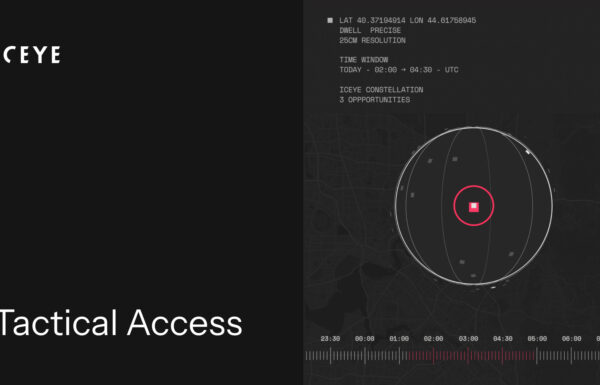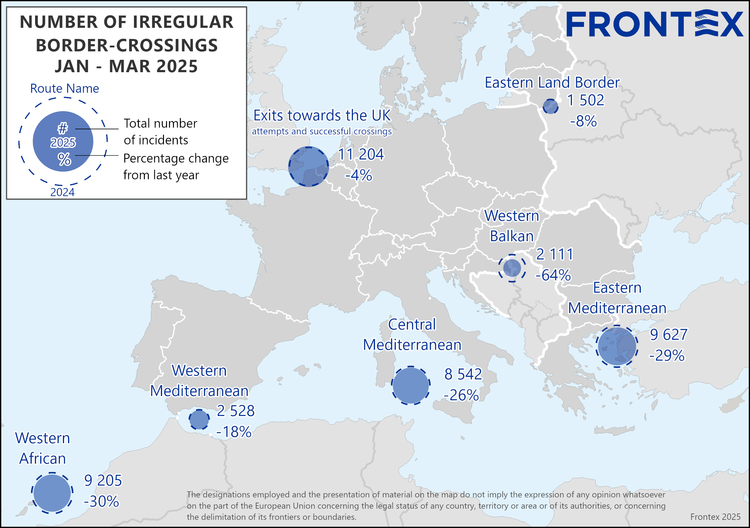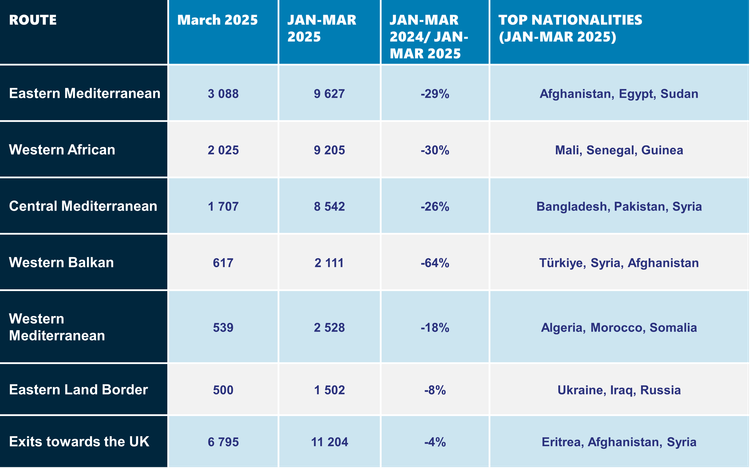According to data published on Friday, April 11, 2025, by the European Border and Coast Guard Agency (Frontex), the number of attempted illegal crossings of the European Union’s external borders in the first quarter of 2025 fell by 31% to nearly 33,600, compared to the same period last year (Illegal Migration to Europe in January 2025).
This decline was observed across all major migration routes into the EU, ranging from a 64% drop along the Western Balkans route to an 8% decrease along the eastern land border of the Union.
Key Events:
- This year, the busiest routes are those from the eastern Mediterranean and West Africa.
- The Western Balkans route recorded the largest decrease in arrivals between January and March (-64%).
- The central Mediterranean route saw a significant year-on-year drop in the number of migrants in March.
- The most common nationalities among migrants: Afghans, Malians, and Bangladeshis.
Approximately 3,200 Frontex officers and civilian staff are stationed at the EU’s external borders, supporting national authorities in efforts to protect Europe’s borders and save lives at sea.
As mentioned, the routes from the eastern Mediterranean and West Africa are the most active illegal migration routes this year. In the east, 9,627 attempted illegal border crossings were recorded between January and March—29% fewer than in the first quarter of 2024. In March alone, there were 3,088 such attempts. Migrants on this route mainly came from Afghanistan, Egypt, and Sudan.
The West African route saw only slightly fewer attempts, with 9,205 recorded, marking a 30% decrease compared to last year (2,025 of which occurred in March alone). Migrants on this route primarily came from Mali, Senegal, and Guinea.
Along the central Mediterranean route, 8,542 attempts to breach EU borders were recorded in the first quarter, including 1,707 in March. This represents a 26% decline compared to the same three-month period last year. The most frequently apprehended migrants were nationals of Bangladesh, Pakistan, and Syria. According to Frontex, poor weather conditions in the Mediterranean Sea were among the contributing factors to this decrease.
Along the Western Balkans route, 2,111 attempted illegal land border crossings were recorded between January and March of this year, with 617 of them occurring in the last reported month alone. This represents a 64% decrease compared to the January–March period in 2024. The most frequently apprehended migrants were citizens of Turkey, Syria, and Afghanistan.
On the Western Mediterranean route, 2,528 attempts to enter EU territory illegally were recorded in the first quarter of this year, including 539 in March alone. This marks an 18% decrease, with most migrants identified as nationals of Algeria, Morocco, and Somalia.
On the EU’s eastern border (Poland, Lithuania, and Latvia with Belarus, and Poland with Ukraine), 1,502 illegal crossing attempts were recorded between January and March—an 8% decrease compared to the same period last year. In March alone, there were 500 such cases. Most of those apprehended were citizens of Ukraine, Iraq, and Russia.
Along the Channel route, the number of detected individuals attempting to cross into the United Kingdom fell by 4% compared to the previous year, to 11,204. In March alone, there were 6,795 such attempts, making it the busiest illegal migration route into the EU. The most frequently apprehended migrants were nationals of Eritrea, Afghanistan, and Syria.



































